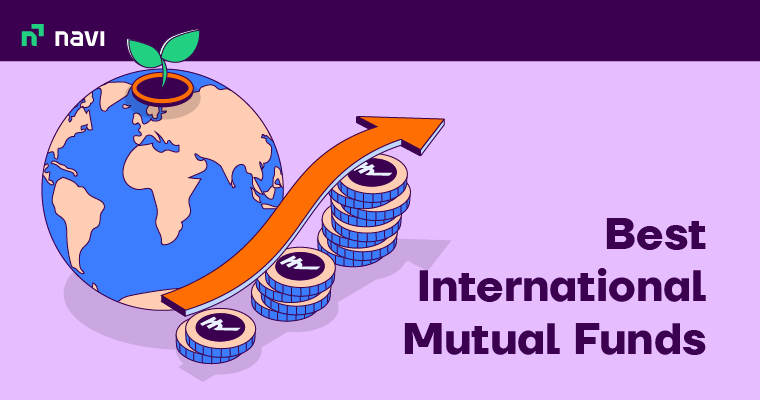10 Best International Mutual Funds in India to Invest in April 2023

International mutual funds are a type of mutual fund that invest in companies that are not listed on India’s stock exchange. These funds invest in equity and equity-related instruments of top-performing international companies. All fund-of-fund schemes are considered as international mutual funds. If you want to diversify your investment portfolio and invest in international mutual funds, here’s a list of the best international mutual funds in India in 2023.
10 Best International Mutual Funds in India 2023
Here are the best international mutual funds 2023 in India that you can invest:
| S No. | Name of the Mutual Funds | 5-Year Annualised Returns |
| 1. | DSP World Mining Fund- Direct-Growth | 16.20% |
| 2. | Kotak Multi Asset Allocator Fund of Fund- Dynamic- Direct-Growth | 15.30% |
| 3. | ICICI Prudential US Bluechip Equity Fund- Direct-Growth | 15.70% |
| 4. | ICICI Prudential Thematic Advantage Fund (FoF)- Direct-Growth | 14.60% |
| 5. | DSP US Flexible Equity Fund- Direct-Growth | 14.70% |
| 6. | Nippon India US Equity Opportunities Fund Direct Plan Growth | 13.60% |
| 7. | PGIM India Global Equity Opportunities Fund- Direct-Growth | 15% |
| 8. | Franklin India Feeder Franklin US Opportunities Fund- Direct-Growth | 12.80% |
| 9. | Edelweiss Greater China Equity Off-shore Fund- Direct-Growth | 7.90% |
| 10. | Aditya Birla Sun Life Global Emerging Opportunities Fund- Direct-Growth | 9% |
Disclaimer: Mutual fund investments are subject to market risks, read all scheme-related documents carefully.
If you want to invest in and capture the high returns potential of international markets in a cost-effective, transparent, and simple manner, you could also consider the Navi NASDAQ 100 Fund of Fund and the Navi US Total Stock Market Fund of Fund. Investment starts at just ₹10.
Disclaimer: Mutual Fund investments are subject to market risks, read all scheme-related documents carefully.
Also Read
Performance of Best International Mutual Funds 2023
Now, let us take a look at the best-performing international mutual funds in India:
1. DSP World Mining Fund- Direct- Growth
Often considered to be one of the best international mutual funds, the DSP World Mining Fund was launched on January 1, 2013, and invests majorly in financial sectors. Its expense ratio may be slightly higher than similar funds in the same category. An important factor that investors may want to consider about DSP World Mining Fund is that it has yielded 17.94% p.a. on a 3-year trailing basis. Given below are crucial details:
- Fund Size: ₹188.92 crore
- Expense ratio: 1.50%
- Type of Fund: Fund of Funds
- NAV:₹17.62
- Risk: Very high
- Minimum Investment (lump sum): ₹500
- Minimum Investment (SIP): ₹500
- Returns:
- Annualised 1-Year Return: -9.30%
- Annualised 3-Year Return: 34.50%
- Annualised 5-Year Return: 16.20%
2. Kotak Multi Asset Allocator Fund of Fund- Dynamic- Direct- Growth
Often considered to be among the top-performing international mutual funds, Kotak Multi Asset Allocator Fund of Fund was launched on January 9, 2013. Currently, it invests 53.8% in equities, 23.2% in debt, and the remaining portion is held as cash. In terms of sectoral allocation, Kotak Multi Asset Allocator Fund of Funds invests 100% equities and about 98.7% debt in the financial sector. Given below are more details:
- Fund Size: ₹783.79 crore
- Expense ratio: 0.13%
- Type of Fund: Fund of funds
- NAV: ₹159.12
- Risk: High
- Minimum Investment (lump sum): ₹5,000
- Minimum Investment (SIP): ₹1,000
- Returns:
- Annualised 1-Year Return: 10.20%
- Annualised 3-Year Return: 26.70%
- Annualised 5-Year Return: 15.30%
3. ICICI Prudential US Bluechip Equity Fund- Direct- Growth
This scheme was launched on January 2, 2013 and aims to generate long-term capital appreciation by investing in equities and equity-linked securities. To be precise, it invests in companies listed on recognised stock exchanges in the United States of America. Most of its investments are in technology, healthcare, capital goods and financial sectors. Provided below are its details:
- Fund Size: ₹2,365.38 crore
- Expense ratio: 1.22%
- Type of Fund: Sectoral/Thematic
- NAV: ₹53.32
- Risk: Very high
- Minimum Investment (lump sum): ₹5,000
- Minimum Investment (SIP): ₹100
- Returns:
- Annualised 1-Year Return: 4.90%
- Annualised 3-Year Return: 20%
- Annualised 5-Year Return: 17%
4. ICICI Prudential Thematic Advantage Fund (FoF)- Direct-Growth
Based on several parameters, the ICICI Prudential Thematic Advantage Fund (FoF) could be one of the best fund of funds in India. It was launched on April 4, 2013. Currently, it invests 85% of the corpus in equity and 6.8% in debt. The remaining is currently held as cash or cash receivables. The scheme aims to provide long-term capital appreciation by investing in various thematic/sectoral funds. For more details, take a look below:
- Fund Size: ₹958.68 crore
- Expense ratio: 0.25%
- Type of Fund: Fund of funds
- NAV: ₹138.85
- Risk: Very high
- Minimum Investment (Lump sum): 5,000
- Minimum Investment (SIP): 1,000
- Returns:
- Annualised 1-Year Return: 5.6%
- Annualised 3-Year Return: 37.2%
- Annualised 5-Year Return: 14.6%
5. DSP US Flexible Equity Fund Direct Plan Growth
DSP US Flexible Equity Fund was launched on January 1, 2013. It is a feeder fund for Black Rock Global Funds- US Flexible Equity Fund. It currently invests 98.8% of the corpus in equities, of which 100% is invested in the financial sector. When it comes to asset allocation, this international mutual fund currently holds 1.2% of its assets in cash. More details are as follows:
- Fund Size: ₹770.53 crore
- Expense ratio: 1.52%
- Type of Fund: Fund of funds
- NAV: ₹45.18
- Risk: Very high
- Minimum Investmen (Lump sum): ₹500
- Minimum Investmen (SIP): ₹500
- Returns:
- Annualised 1-Year Return: -1.1%
- Annualised 3-Year Return: 22.2%
- Annualised 5-Year Return: 14.7%
6. Nippon India US Equity Opportunities Fund- Direct-Growth
This international mutual fund was launched on July 23, 2015, and currently invests 99.6% in equities. When it comes to sector-wise asset allocation, the scheme invests in services, technology, finance, healthcare, and energy-related companies among others. Since its inception, this fund has been able to double its investments every 6 years. Given below are its details:
- Fund Size: ₹534.43 crore
- Expense ratio:1.30%
- Type of Fund: Sectoral/Thematic
- NAV: ₹24.48
- Risk: Very high
- Minimum Investment (Lump sum): ₹100
- Minimum Investment (SIP): ₹100
- Returns:
- Annualised 1-Year Return: -8.1%
- Annualised 3-Year Return: 15.5%
- Annualised 5-Year Return: 13.6%
7. PGIM India Global Equity Opportunities Fund- Direct-Growth
This scheme was officially launched on January 8, 2013, and it is considered to be a medium-sized fund in its category. Its expense ratio is 1.43% at present. Like many other international funds, most of its investments are in one fund- PGIM Jennison Global Equity Opportunities Fund. Take a look at its details:
- Fund Size: ₹1,220.79 crore
- Expense ratio: 1.43%
- Type of Fund: Fund of funds
- NAV: ₹30.46
- Risk: Very high
- Minimum Investment (lump sum): ₹5,000
- Minimum Investment (SIP): ₹1,000
- Returns:
- Annualised 1-Year Return: -8.4%
- Annualised 3-Year Return: 7.5%
- Annualised 5-Year Return: 12.6%
8. Franklin India Feeder Franklin US Opportunities Fund- Direct-Growth
This scheme was officially launched on January 2, 2013, and since then, it has delivered -12.16% average annual returns. Like some other funds in the same category, it invests primarily in Franklin US Opportunities Fund, a global fund that invests mostly in US stocks. Take a look at its details:
- Fund Size: ₹2,880.45 crore
- Expense ratio: 0.5%
- Type of Fund: Fund of Funds
- NAV: ₹50.22
- Risk: Very high
- Minimum Investment (Lump sum): ₹5,000
- Minimum Investment (SIP): ₹500
- Returns:
- Annualised 1-Year Return: -13.8%
- Annualised 3-Year Return: 12.9%
- Annualised 5-Year Return: 12.8%
9. Edelweiss Greater China Equity Off-shore Fund- Direct-Growth
This scheme was officially launched on January 2, 2013, and invests mostly in the financial sector. It aims to provide long-term capital appreciation from companies located in the Greater China region. For this purpose, it invests in JPMorgan Funds- Greater China Fund. Provided below are more details:
- Fund Size: ₹1,897.84 crore
- Expense ratio: 1.44%
- Type of Fund: Fund of funds
- NAV: ₹43.09
- Risk: Very high
- Minimum Investment (Lump sum): ₹5,000
- Minimum Investment (SIP): ₹500
- Returns:
- Annualised 1-Year Return: -2.2%
- Annualised 3-Year Return: 8.4%
- Annualised 5-Year Return: 7.9%
10. Aditya Birla Sun Life Global Emerging Opportunities Fund- Direct-Growth
This scheme was launched on January 3, 2013. The global fund that this scheme primarily invests in is the Julius Baer Equity Next Generation Fund. The fund currently invests 98.9% in equities and holds the remaining corpus as cash. Take a look at the important details of the fund:
- Fund Size: ₹261.51 crore
- Expense ratio: 0.70%
- Type of Fund: Fund of Funds
- NAV: ₹19.53
- Risk: Very high
- Minimum Investment (Lump sum): ₹100
- Minimum Investment (SIP): ₹1,000
- Returns:
- Annualised 1-Year Return: –11.6%
- Annualised 3-Year Return: 14.5%
- Annualised 5-Year Return: 9%
*Data correct as of 31st March, 2023
Disclaimer: Mutual fund investments are subject to market risks, read all scheme-related documents carefully.
How Do International Mutual Funds Work?
The process of investing in international mutual funds is similar to equity fund investment. The investment amount is in rupees and in return, investors receive mutual fund units. The fund manager allocates the investment amount as per the fund’s objective. Generally, the amount gets invested in equities of companies listed on stock exchanges abroad.
There are primarily two ways in which fund managers invest in equities abroad:
- Fund managers might make direct purchases of equities to build the entire investment portfolio
- They can also invest in international funds holding shares of foreign companies following the ‘fund of fund’ structure.
Having international affiliations was the underlying concept with which international mutual funds began operating. For example, DSP offers units of Blackrock Funds to Indian mutual fund investors, while Franklin Templeton offers its own international fund via an Indian fund of funds.
Also Read
Types of International Funds
1. Global Market Funds
These funds allow investors from any country, including their home country to invest. These funds invest in companies worldwide across various asset classes for better diversification.
2. Regional Funds
These are country-specific funds that invest in companies of a specific country or region. For example, a regional fund can invest in US stocks or top European companies only.
3. Country Funds
A country fund invests in stocks of a specific country, for example, the US or China. This makes it easy for fund managers to study and analyse the particular market in a better way.
4. Thematic International Funds
Such funds follow a theme-based investment approach investing in the overseas stocks of a specific theme/sector. For example, an international mutual fund with an infrastructure theme will invest in shares of foreign steel, cement and power companies.
5. International Commodity Funds
These work well for investors looking to invest in a particular precious commodity. International mineral funds and gold funds are examples of this type of mutual fund.
Who Should Invest in International Mutual Funds?
- Investors looking to invest in global market leaders to have a share of their profits
- Equity investors with a well-diversified portfolio comprising Indian stocks can diversify their investments further with international funds
- Investors with a strong knowledge about international markets
- Investors who want to leverage opportunities in different markets
- Long-term investors looking to accumulate a large corpus via dollar appreciation against rupee
How to Invest in Best International Mutual Funds?
Listed below are the steps you need to follow to invest in the best international mutual funds in India:
- Step 1
Decide on your investment goals and assess your risk appetite.
- Step 2
Consult a financial expert, if required, to find out which international scheme is most aligned with your financial goals and risk-taking capacity.
- Step 3
You can invest in the chosen scheme by visiting the official website of the fund house.
- Step 4
Register online on the AMC’s official website, navigate to the ‘mutual funds’ section and select the scheme.
- Step 5
Choose the investment mode, enter the amount and click on ‘Proceed’.
- Step 6
Fill up the form with your KYC and details of your PAN and bank account
- Step 7
Deposit the initial investment amount to initiate your investment.
Benefits of Investing in International Mutual Funds
The following are some of the advantages of investing in international funds:
1. Geographical Diversification
By diversifying your investments globally, you get the benefits of markets not correlated to India. When the Indian economy is struggling, you can get better returns from foreign markets.
2. Investing in Top-Performing Companies
Some of the global market leaders, such as Google, Microsoft, Apple, Facebook and Amazon, etc., are located on foreign stock exchanges. If you want to invest in these brands, international funds can be a suitable option.
3. Currency Diversification
When investing in international funds, you get exposure to foreign currency by investing in rupees. Any appreciation in the value of the foreign currency against the rupee would increase your returns.
4. Reduce Risk and Volatility
Exposure to different economies lets you capitalise on gains while balancing risk. It also reduces the overall volatility of your portfolio as losses from one region are covered by gains from others.
Factors to Consider before Investing in International Mutual Funds
1. Investment Risks
Investing in global markets can carry unpredictable risks. Political turmoil, economic downturns and changes in policies can take a toll on your investment. Hence, investors may want to check their risk appetite before considering such investments.
2. Financial Goals
Different international funds have their unique strategies for constructing a portfolio. Some funds may invest in Indian and foreign equity, while others may invest in a particular theme or sector. Investors may want to check if the asset allocation is in line with their financial goals.
3. Expense Ratio
All Asset Management Companies (AMCs) charge a fee called expense ratio to cover their administrative and operating expenses. When choosing an international mutual fund, it is vital that you check its expense ratio and compare it with the expense ratio of other funds in the same category. This is because the expense ratio has an impact on the returns you earn.
4. Role of the Fund Manager
The fund manager needs to have in-depth knowledge and expertise about the global markets for these mutual fund schemes. Hence, it is important for investors to check their experience in managing similar funds and their performance before choosing a fund.
Taxation of International Funds in India
Although international mutual funds invest primarily in stocks, they are an anomaly when it comes to taxation. Returns from these investments are taxed as non-equity funds.
For a holding period of less than three years, short-term capital gains (STCG) are added to your gross income and taxed as per the income tax slab. For a holding period of over 3 years, long-term capital gains (LTCG) tax is applicable at a 20% rate after indexation.
Final Word
International mutual funds give a wide range of choice to Indian investors to invest in various global companies. Investors can use them to benefit from booming markets in other countries. However, always consider your investment goals and risk appetite before choosing the best international mutual fund 2023.
In case you are worried about the risks of investing in international funds, you can always start small with Navi’s international mutual fund schemes like US Total Stock Market Fund of Fund or NASDAQ 100. With Navi Mutual Fund, you can start investing with as low as Rs.10!
FAQs
The investment horizon of an individual is completely dependent upon his/her financial goals. That said, one might want to have a long term investment horizon to protect their finances from the volatility of equity markets. Furthermore, staying invested for the long term allows you to benefit from the power of compounding.
Net Asset Value (NAV) is the per-unit market value of all assets held by a mutual fund scheme. To calculate this, you have to add the market value of all securities and subtract all liabilities and expenses. Then, you need to divide the figure by the total number of outstanding units.
Here are some tips to follow for investing in international funds:
• Have thorough knowledge of the market
• Do your research regarding the credit risk, default risk, and fund allocation
• Read the offer documents carefully
• Choose a country with strong legal systems and stable markets
Yes, you can invest in international mutual funds in India as quite a few reputed fund houses offer international funds to investors. Moreover, the international market offers Indians a wide range of investment options ranging from funds of funds (FoF) and sectoral funds to ETFs.
International mutual funds are a good investment option for Indian investors who already have a well-diversified portfolio of Indian stocks. They can consider international schemes for further diversification as they would be able to generate good returns. It is also a good investment option for investors who wish to invest in global companies to make profits from international markets.
International mutual funds fall under the purview of the Securities and Exchange Board of India (SEBI) which makes them safe and secure from fraud or malpractice. Moreover, these schemes offer the benefit of geographical diversification which reduces risks associated with domestic markets. However, like any other equity investments, international funds also carry certain degrees of risk. But as an investor, you can mitigate this risk through long-term investments and a diversified portfolio.
Some of the best international mutual funds in India are as follows:
1. DSP World Mining Fund
2. Kotak Multi Asset Allocator Fund of Fund
3. ICICI Prudential US Bluechip Equity Fund
4. ICICI Prudential Thematic Advantage Fund (FoF)
5. DSP US Flexible Equity Fund
The answer to this depends on an investor’s risk appetite and investment goals. As a beginner, you can start investing in international funds with Navi Mutual Fund at just Rs.10!
Want to put your savings into action and kick-start your investment journey 💸 But don’t have time to do research? Invest now with Navi Nifty 50 Index Fund, sit back, and earn from the top 50 companies.
Disclaimer: Mutual Fund investments are subject to market risks, read all scheme-related documents carefully.
This article has been prepared on the basis of internal data, publicly available information and other sources believed to be reliable. The information contained in this article is for general purposes only and not a complete disclosure of every material fact. It should not be construed as investment advice to any party. The article does not warrant the completeness or accuracy of the information and disclaims all liabilities, losses and damages arising out of the use of this information. Readers shall be fully liable/responsible for any decision taken on the basis of this article.

10 Best Demat Accounts in India for Beginners in 2023
Creation of Demat accounts revolutionised the way trades were conducted at the stock exchanges. It... Read More »10 Best SIP Plans for 1000 Per Month in India 2023
Systematic Investment Plan (SIP) is an investment style or route with which you can invest a fixed ... Read More »How to Invest in Mutual Funds in India – Easy Steps
Mutual funds can be an excellent way to diversify your portfolio and gain exposure to a wide range ... Read More »20 Best Nifty 50 Index Funds in India to Invest in April 2023
What is the Nifty 50 Index Fund? Nifty 50 index funds are a type of passively-managed equi... Read More »Asset Management Company (AMC) – Types and Benefits
What is an Asset Management Company (AMC)? Asset Management Company or AMC is a financial ... Read More »10 Best Gold Mutual Funds to Invest in India (April 2023)
Gold Mutual Funds are funds that invest in gold and gold-related assets such as bullion, coin... Read More »20 Best Flexi Cap Mutual Funds to Invest in India 2023
Flexi-cap funds are mutual fund schemes that aim to invest in stocks of companies across market cap... Read More »Best SIP Plans for 15 years – Top 10 SIP Plans to Invest in India 2023
A systematic investment plan (SIP) could be a convenient mode or style of investing in mutual funds... Read More »10 Best SIP Plans for 1 year Investment in India 2023
There has been a massive surge in SIP or Systematic Investment Plan investors in recent years. As p... Read More »10 Best SIP Plan for 3 Years in India to Invest in 2023
SIP or Systematic Investment Plan helps bring investment discipline in an investor’s life. It’s... Read More »10 Best SIP Plan for 10 years India in 2023 – Returns and Performance
Ask any beginner mutual fund investor and most of them would tell you that their preferred mode of ... Read More »10 Best SIP Plans for 5 years in India to Invest in 2023
Systematic Investment Plan (SIP) could be an effective investment mode if you want to invest a fixe... Read More »Top 10 Chit Fund Schemes in India in 2023
Chit funds are one of the most popular return-generating saving schemes in India. It is a financial... Read More »10 Best Gold ETFs in India to Invest in April 2023
Gold ETFs or Gold Exchange Traded Funds are passively managed funds that track the price of physica... Read More »10 Best Demat Accounts in India for Beginners in 2023
Creation of Demat accounts revolutionised the way trades were conducted at the stock exchanges. It... Read More »20 Best Index Funds to Invest in India in April 2023
What is an Index Fund? An index fund is a type of mutual fund or exchange-traded fund (ETF) that... Read More »Best Arbitrage Mutual Funds to Invest in India in April 2023
Arbitrage funds are hybrid mutual fund schemes that aim to make low-risk profits by buying and sell... Read More »10 Best SIP Plans in India to Invest in April 2023
What is SIP? SIP or Systematic Investment Plan is a method of investing a fixed amount in ... Read More »10 Best Corporate Bond Funds in India to Invest in April 2023
Corporate bond funds are debt funds that invest at least 80% of the investment corpus in companies ... Read More »10 Best Bank for Savings Account in India [Highest Interest Rate 2023]
Savings account is a type of financial instrument offered by several banks. It lets you safely depo... Read More »

































